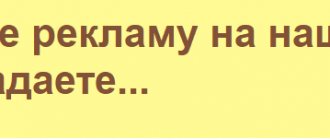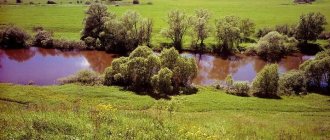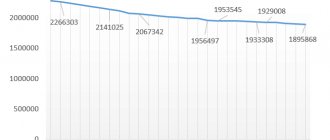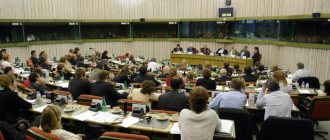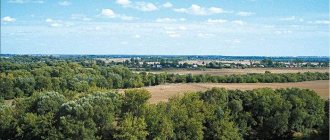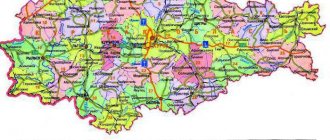Administrative-territorial structure of the Kursk region
is a system of administrative-territorial units and settlements available in the region, ensuring the orderly implementation of public administration functions on its territory. When implementing local self-government within the boundaries of districts and village councils, they retain the status of independent units of the administrative-territorial structure of the region.
Administrative division
The administrative-territorial units of the region are districts and village councils:
- district - an administrative-territorial unit that includes village councils, urban and rural settlements;
- village council is an administrative-territorial unit that includes one or more rural settlements.
The register of administrative-territorial units of the Kursk region includes:
- 28 districts,
- 480 village councils.
Urban settlements include cities of regional and district significance, urban-type settlements (working settlements). The register of urban settlements in the Kursk region includes:
- 5 cities of regional significance,
- 5 cities of regional significance,
- 22 workers' settlements.
Rural settlements include settlements (rural-type settlement, village, hamlet, hamlet, settlement, etc.) that are not classified as urban settlements. The register of rural settlements in the Kursk region includes 2775 settlements:
- 1366 villages,
- 10 villages near the station,
- 300 rural villages,
- 4 crossing points,
- 1 place
- 639 villages,
- 8 settlements,
- 447 farms.
Notes[ | ]
- ↑ 12
Charter of the Kursk region - Law “On the administrative-territorial structure of the Kursk region”
- ↑ 1234
Register of administrative-territorial units and settlements of the Kursk region Archived copy dated November 21, 2021 on the Wayback Machine; Register of administrative-territorial units and settlements of the Kursk region - Law of the Kursk Region No. 48-ZKO “On Municipal Entities of the Kursk Region” dated October 14, 2004 Archived January 26, 2009.
- Rosstat. Distribution of municipal institutions by type of municipality as of January 1, 2021.
- ↑ 123456789101112131415161718192021222324252627282930313233
The permanent population of the Russian Federation by municipalities as of January 1, 2021 (Russian). Date accessed: April 27, 2021. Archived May 2, 2021. - ↑ 12
s: Resolution of the All-Russian Central Executive Committee of the RSFSR dated January 18, 1935 on the new district network of the Kursk region - Rakov V.V.
Year of birth – 1934: To the 80th anniversary of the formation of the Kursk region //
State Archives of the Kursk Region
History of the region in the history of the country: materials of the Regional scientific and practical. Conf. dedicated to the 80th anniversary of the formation of the Kursk region / ed. V.L. Bogdanov. - Kursk, 2014. - P. 11. - Kurchatov today - brief information about Kurchatov on the city’s official website
History of administrative-territorial division
On June 13, 1934, by the Decree of the All-Russian Central Executive Committee and the Council of People's Commissars of the RSFSR, the Central Black Earth Region was divided into Kursk and Voronezh regions. The newly formed Kursk region included 60 districts.
On January 18, 1935, a new network of districts was approved. Almost all previously existing areas were restored and new ones were created. The total number of districts reached 93.
On September 27, 1937, 25 districts were transferred from the Kursk region to the newly formed Oryol region (Bolkhovsky, Verkhovsky, Volynsky, Dolzhansky, Droskovsky, Zalegoshchensky, Znamensky, Izmalkovsky, Kolpnyansky, Korsakovsky, Krasnozorensky, Kromskoy, Livensky, Mokhovsky, Mtsensky, Nikolsky, Novoderevenkovsky, Novosilsky, Oryol, Pokrovsky, Russko-Brodsky, Sverdlovsky, Soskovsky, Telchensky and Uritsky), in 1939 the Dolgorukovsky district was also transferred to the Oryol region.
On July 13, 1944, 5 more districts were transferred from the Kursk region to the Oryol region (Glazunovsky, Dmitrovsky, Maloarkhangelsky, Ponyrovsky, Trosnyansky). In October of the same year, the Ponyrovsky district was returned to the Kursk region.
On January 6, 1954, in connection with the formation of the Belgorod and Lipetsk regions, 23 districts were transferred from the Kursk region (Belgorodsky, Belenikhinsky, Bobrovo-Dvorsky, Bolshe-Troitsky, Borisovsky, Valuysky, Veliko-Mikhailovsky, Volokonovsky, Grayvoronsky, Ivnyansky, Korochansky, Krasnoyaruzhsky, Mikoyanovsky, Novo-Oskolsky, Prokhorovsky, Rakityansky, Sazhensky, Skorodnyansky, Staro-Oskolsky, Tomarovsky, Urazovsky, Chernyansky and Shebekinsky), the second - 3 districts (Bolshe-Polyansky, Volovsky and Terbunsky). There are 36 districts left in the Kursk region. Subsequently, all changes concerned the internal administrative-territorial division of the region; the borders, until now, have not been revised. The regional centers of 8 districts were cities (the center of the Streletsky district - Kursk was not included in the Streletsky district itself, being the only city of regional subordination), the centers of 2 districts (Timsky and Koronevsky) were urban-type settlements, the centers of the remaining 26 districts were villages or (Sovetsky) settlements included in the village councils, while the village named after Karl Liebknecht was part of the Ivaninsky district without being its regional center, the center of which was the village of Lukashevka, another urban-type settlement that existed at that time - Pervoavgustovsky was part of the Dmitrievsky district.
In 1956, Krivtsovsky, Oktyabrsky (the eastern part of the Sovetsky district) and Yasenovsky districts were abolished, as a result of which the total number of districts in the Kursk region was reduced to 33.
In 1957, the village of Tyotkino became an urban-type settlement; in 1958, the Sovetsky settlement was removed from the village council and became an urban-type settlement; in 1959, the villages of Glushkovo, Kastornoye and Maryino (now Pristen) became urban-type settlements.
By decree of the Presidium of the Supreme Council of the RSFSR of February 1, 1963, administrative rural districts were enlarged: instead of 33 there were 12 (Gorshechensky, Dmitrievsky, Zolotukhinsky, Kursky, Lgovsky, Oboyansky, Rylsky, Solntsevsky, Sovetsky, Sudzhansky, Fatezhsky and Shchigrovsky districts). At the same time, Zheleznogorsk, Lgov and Shchigram were given the status of cities of regional subordination.
On March 3, 1964, the number of districts was increased to 14 (Kastorensky and Timsky districts were added). On January 12, 1965, the Kursk region became part of 19 districts (Belovsky, Glushkovsky, Zheleznogorsky, Konyshevsky and Pristensky districts were created). In the same year, the village of Olmysky received the status of an urban-type settlement. The division of areas into rural and industrial was abolished.
On December 30, 1966, 3 new districts were formed: Korenevsky, Khomutovsky and Cheremisinovsky. The total number of districts became 22. In 1967, the villages of Gorshechnoye, Zolotukhino, Solntsevo and Khomutovka became urban-type settlements, and a year later - the village of Konyshevka.
On December 9, 1970, Medvensky, Oktyabrsky and Ponyrovsky districts were formed. In 1971, the urban-type settlement of Kurchatov was founded, and the villages of Ponyri, Solntsevo and Cheremisinovo became urban-type settlements, in 1973 - the village of Pryamitsyno, in 1974 - the village of Medvenka and the village of Kirovsky
On March 23, 1977, 3 more districts were formed: Bolshesoldatsky, Kurchatovsky and Manturovsky. The total number of districts reached 28.
On April 25, 1983, by Decree of the Presidium of the Supreme Soviet of the RSFSR No. 5-91/3, the workers' village of Kurchatov was given the status of a city of regional subordination[1].
At Kursk State University, 89 percent of employees and 66 percent of students have been vaccinated
KO administration A mobile vaccination team is working at KSU; teachers, students, including foreigners, can get vaccinated against coronavirus
Teams go to the university 2 times a week. It is possible to pre-register and choose one of the vaccines registered in Russia. According to the regional administration, doctors vaccinate from 50 to 80 people during one visit.
– We cooperate with the Kursk Dermatovenous Dispensary and City Clinic No. 1, and we also involve employees of the university health center in this work. We are revaccinating. I was vaccinated in January and revaccinated in July. We are interested in classes being held in person, so we urge all students to get vaccinated against coronavirus,” said KSU Rector Alexander Khudin.
In total, according to the latest data, 89% of employees and 66% of students have been vaccinated at KSU.
Municipal division
In accordance with Federal Law No. 131-FZ “On the General Principles of the Organization of Local Self-Government in the Russian Federation” dated October 6, 2003 and the Law of the Kursk Region No. 48-ZKO “On Municipal Entities of the Kursk Region” dated October 14, 2004 in the Kursk Region within the boundaries administrative districts, municipalities were formed with the status of a municipal district, and within the boundaries of cities of regional subordination, municipalities were formed with the status of a city district[2].
As of January 1, 2010, the Kursk region included 540 municipalities:
- 5 urban districts,
- 28 municipal districts,
- 27 urban settlements,
- 480 rural settlements.
As of January 2, 2011, the Kursk region includes 355 municipalities:
- 5 urban districts,
- 28 municipal districts,
- 27 urban settlements,
- 295 rural settlements.
Urban districts
| No. | Urban district | Area, km² | Population, people |
| 1 | Zheleznogorsk | 112 | ↗99 683[3] |
| 2 | Kursk | 189 | ↗443 212[3] |
| 3 | Kurchatov | 55 | ↘38 917[3] |
| 4 | Lgov | 38 | ↘19 533[3] |
| 5 | Shchigry | 21 | ↘15 678[3] |
Municipal districts
Municipal districts of the Kursk region are formed within the boundaries of the administrative districts of the same name.
| No. | Municipal district | Center | Area, km² | Population, people | Population density, people/km² | Qty | Quantity (2006) | Quantity (2011) |
| 1 | Belovsky | sl. White | 950 | ↘15 584[3] | 16,7 | — | 18 | 14 |
| 2 | Bolshesoldatsky | With. Bolshoye Soldatskoye | 780 | ↘11 280[3] | 14,8 | — | 12 | 7 |
| 3 | Glushkovsky | Glushkovo village | 860 | ↘19 845[3] | 23,6 | 2 | 14 | 11 |
| 4 | Gorshechensky | urban village Gorshechnoye | 1 400 | ↘16 371[3] | 12,0 | 1 | 15 | 14 |
| 5 | Dmitrievsky | Dmitriev | 1 270 | ↘15 176[3] | 12,3 | 1 | 19 | 7 |
| 6 | Zheleznogorsk | Zheleznogorsk | 991 | ↘16 126[3] | 16,4 | 1 | 18 | 17 |
| 7 | Zolotukhinsky | Zolotukhino village | 1 150 | ↘22 059[3] | 19,4 | 1 | 19 | 9 |
| 8 | Kastorensky | urban village Kastornoye | 1 230 | ↘15 587[3] | 12,9 | 3 | 21 | 13 |
| 9 | Konyshevsky | village Konyshevka | 1 070 | ↘8848[3] | 8,4 | 1 | 18 | 9 |
| 10 | Korenevsky | Korenevo village | 850 | ↘16 299[3] | 19,5 | 1 | 16 | 9 |
| 11 | Kursk | Kursk | 1 620 | ↗57 315[3] | 35,4 | — | 21 | 17 |
| 12 | Kurchatovsky | Kurchatov | 700 | ↗18 726[3] | 26,6 | 2 | 10 | 6 |
| 13 | Lgovsky | Lgov | 1 080 | ↘12 364[3] | 11,9 | — | 17 | 8 |
| 14 | Manturovsky | With. Manturovo | 1 010 | ↘12 588[3] | 12,6 | — | 19 | 7 |
| 15 | Medvensky | town Medvenka | 1 090 | ↘16 237[3] | 15,0 | 1 | 15 | 10 |
| 16 | Oboyansky | Oboyan | 1 090 | ↗29 834[3] | 27,3 | 1 | 19 | 12 |
| 17 | October | Pryamitsyno village | 620 | ↗24 657[3] | 39,6 | 1 | 10 | 10 |
| 18 | Ponyrovsky | Ponyri village | 690 | ↘11 017[3] | 16,3 | 1 | 13 | 7 |
| 19 | Pristensky | village Pristen | 1 010 | ↘15 513[3] | 15,5 | 2 | 18 | 8 |
| 20 | Rylsky | Rylsk | 1 550 | ↘31 693[3] | 20,6 | 1 | 27 | 16 |
| 21 | Soviet | town Kshensky | 1 150 | ↘17 294[3] | 15,3 | 1 | 18 | 10 |
| 22 | Solntsevsky | Solntsevo village | 1 090 | ↘13 810[3] | 12,9 | 1 | 16 | 6 |
| 23 | Sudzhansky | Sudzha | 1 010 | ↗26 433[3] | 26,1 | 1 | 21 | 16 |
| 24 | Timsky | Tim | 850 | ↘10 914[3] | 13,0 | 1 | 13 | 8 |
| 25 | Fatezhsky | Fatezh | 1 300 | ↘18 512[3] | 14,4 | 1 | 21 | 10 |
| 26 | Khomutovsky | village Khomutovka | 1 150 | ↘9353[3] | 8,4 | 1 | 20 | 8 |
| 27 | Cheremisinovsky | Cheremisinovo village | 840 | ↘9289[3] | 11,1 | 1 | 14 | 8 |
| 28 | Shchigrovsky | Shchigry | 1 220 | ↘10 272[3] | 8,7 | — | 18 | 18 |
Coronavirus statistics in the Kursk region on December 9, 2021
According to the operational headquarters as of December 9, a total of 78,712 (+155) confirmed cases of coronavirus were registered in the Kursk region.
There are 1,360 people in hospitals and hospitals with COVID-19 and pneumonia, 101 on mechanical ventilation (12 - invasive, 89 - non-invasive).
According to operational data from the operational headquarters, 1,876 people have died to date (+6; man 58 years old; women - 66, 71, 75, 76, 83 years old), the cause of death is severe viral pneumonia caused by COVID-19.
605,287 people were vaccinated with the first component of the coronavirus vaccine, of which 557,897 were vaccinated with the second component (completed vaccination).
Links
- [www.terrus.ru/cgi-bin/allrussia/v3_index.pl?act=reg&id=46&from=d_er Kursk region in the directory directory “All Russia”]
- [mun.rkursk.ru/index.php?main_menu_id=3 Website of municipalities of the Kursk region]
- [rkursk.ru/other/raion.html Districts of the Kursk region on the official server of the Administration of the Kursk region]
- [www.kurskcity.ru/firstline.php?id=50423 Kursk region turned 75] - brief information on the history of the administrative-territorial division of the Kursk region // article by the KURSKCiTY news agency, 06/12/2009.
- [guides.rusarchives.ru/browse/guidebook.html?bid=128&sid=37525 State Archives of the Oryol Region. Guide. Certificate of administrative-territorial division of the Oryol region]
- [galo.admlr.lipetsk.ru/Pages/Kratkii_Spravochnik/Prilozenie_1.htm Information on the administrative-territorial division of the Lipetsk region (1918-1985) on the website of the State Archives of the Lipetsk Region]
Notes
- [www.kurchatov.info/o-gorode/kurchatov-segodnya Kurchatov today] - brief information about Kurchatov on the official website of the city
- [www.oblduma.kursknet.ru/zd3/04-48zko.html Law of the Kursk Region No. 48-ZKO “On Municipal Entities of the Kursk Region” dated October 14, 2004]
- ↑ 123456789101112131415161718192021222324252627282930313233
www.gks.ru/free_doc/doc_2016/bul_dr/mun_obr2016.rar Population of the Russian Federation by municipalities as of January 1, 2021
Municipal structure[ | ]
Districts of the Kursk region
In accordance with Federal Law No. 131-FZ “On the General Principles of the Organization of Local Self-Government in the Russian Federation” dated October 6, 2003 and the Law of the Kursk Region No. 48-ZKO “On Municipal Entities of the Kursk Region” dated October 14, 2004 in Kursk region, within the boundaries of administrative districts, municipal entities were formed with the status of a municipal district, and within the boundaries of cities of regional subordination, municipal entities were formed with the status of a city district[4].
Within the framework of the municipal structure of the region, within the boundaries of the administrative-territorial units of the Kursk region, a total of 355 municipalities were formed (as of January 1, 2018)[5]:
- 5 urban districts,
- 28 municipal districts 27 urban settlements
- 295 rural settlements.
As of January 1, 2010, the Kursk region included 540 municipalities:
- 5 urban districts,
- 28 municipal districts, 27 urban settlements,
- 480 rural settlements.
see also
- List of village councils of the Kursk region
- Coats of arms of the districts of the Kursk region
- Cities of the Kursk region
| |||||||||||||||||||||||||||
An excerpt characterizing the administrative-territorial division of the Kursk region
- No, I’ve been looking at you for a long time; I felt it when you came in. No one like you, but gives me that soft silence... that light. I just want to cry with joy. Natasha moved closer to him. Her face shone with rapturous joy. - Natasha, I love you too much. More than anything else. - And I? “She turned away for a moment. - Why too much? - she said. - Why too much?.. Well, what do you think, how do you feel in your soul, in your whole soul, will I be alive? What do you think? - I'm sure, I'm sure! – Natasha almost screamed, taking both his hands with a passionate movement. He paused. - How good it would be! - And, taking her hand, he kissed it. Natasha was happy and excited; and immediately she remembered that this was impossible, that he needed calm. “But you didn’t sleep,” she said, suppressing her joy. – Try to sleep... please. He released her hand, shaking it; she moved to the candle and sat down again in her previous position. She looked back at him twice, his eyes shining towards her. She gave herself a lesson on the stocking and told herself that she wouldn't look back until she finished it. Indeed, soon after that he closed his eyes and fell asleep. He did not sleep for long and suddenly woke up in a cold sweat. As he fell asleep, he kept thinking about the same thing he had been thinking about all the time - about life and death. And more about death. He felt closer to her. "Love? What is love? - he thought. – Love interferes with death. Love is life. Everything, everything that I understand, I understand only because I love. Everything is, everything exists only because I love. Everything is connected by one thing. Love is God, and to die means for me, a particle of love, to return to the common and eternal source.” These thoughts seemed comforting to him. But these were just thoughts. Something was missing in them, something was one-sided, personal, mental - it was not obvious. And there was the same anxiety and uncertainty. He fell asleep. He saw in a dream that he was lying in the same room in which he was actually lying, but that he was not wounded, but healthy. Many different faces, insignificant, indifferent, appear before Prince Andrei. He talks to them, argues about something unnecessary. They are getting ready to go somewhere. Prince Andrey vaguely remembers that all this is insignificant and that he has other, more important concerns, but continues to speak, surprising them, some empty, witty words. Little by little, imperceptibly, all these faces begin to disappear, and everything is replaced by one question about the closed door. He gets up and goes to the door to slide the bolt and lock it. Everything depends on whether he has time or not time to lock her. He walks, he hurries, his legs don’t move, and he knows that he won’t have time to lock the door, but still he painfully strains all his strength. And a painful fear seizes him. And this fear is the fear of death: it stands behind the door. But at the same time, as he powerlessly and awkwardly crawls towards the door, something terrible, on the other hand, is already, pressing, breaking into it. Something inhuman - death - is breaking at the door, and we must hold it back. He grabs the door, strains his last efforts - it is no longer possible to lock it - at least to hold it; but his strength is weak, clumsy, and, pressed by the terrible, the door opens and closes again. Once again it pressed from there. The last, supernatural efforts were in vain, and both halves opened silently. It has entered, and it is death. And Prince Andrei died. But at the same moment as he died, Prince Andrei remembered that he was sleeping, and at the same moment as he died, he, making an effort on himself, woke up. “Yes, it was death. I died - I woke up. Yes, death is awakening! - his soul suddenly brightened, and the veil that had hitherto hidden the unknown was lifted before his spiritual gaze. He felt a kind of liberation of the strength previously bound in him and that strange lightness that has not left him since then. When he woke up in a cold sweat and stirred on the sofa, Natasha came up to him and asked what was wrong with him. He did not answer her and, not understanding her, looked at her with a strange look. This was what happened to him two days before the arrival of Princess Marya. From that very day, as the doctor said, the debilitating fever took on a bad character, but Natasha was not interested in what the doctor said: she saw these terrible, more undoubted moral signs for her. From this day on, for Prince Andrei, along with awakening from sleep, awakening from life began. And in relation to the duration of life, it did not seem to him slower than awakening from sleep in relation to the duration of the dream. There was nothing scary or abrupt in this relatively slow awakening. His last days and hours passed as usual and simply. And Princess Marya and Natasha, who did not leave his side, felt it. They did not cry, did not shudder, and lately, feeling this themselves, they no longer walked after him (he was no longer there, he left them), but after the closest memory of him - his body. The feelings of both were so strong that the external, terrible side of death did not affect them, and they did not find it necessary to indulge their grief. They did not cry either in front of him or without him, but they never talked about him among themselves. They felt that they could not put into words what they understood. They both saw him sink deeper and deeper, slowly and calmly, away from them somewhere, and they both knew that this was how it should be and that it was good. He was confessed and given communion; everyone came to say goodbye to him. When their son was brought to him, he put his lips to him and turned away, not because he felt hard or sorry (Princess Marya and Natasha understood this), but only because he believed that this was all that was required of him; but when they told him to bless him, he did what was required and looked around, as if asking if anything else needed to be done. When the last convulsions of the body, abandoned by the spirit, took place, Princess Marya and Natasha were here. – Is it over?! - said Princess Marya, after his body had been lying motionless and cold in front of them for several minutes. Natasha came up, looked into the dead eyes and hurried to close them. She closed them and did not kiss them, but kissed what was her closest memory of him. “Where did he go? Where is he now?..” When the dressed, washed body lay in a coffin on the table, everyone came up to him to say goodbye, and everyone cried. Nikolushka cried from the painful bewilderment that tore his heart. The Countess and Sonya cried out of pity for Natasha and that he was no more. The old count cried that soon, he felt, he would have to take the same terrible step. Natasha and Princess Marya were also crying now, but they were not crying from their personal grief; they wept from the reverent emotion that gripped their souls before the consciousness of the simple and solemn mystery of death that had taken place before them. The totality of causes of phenomena is inaccessible to the human mind. But the need to find reasons is embedded in the human soul. And the human mind, without delving into the innumerability and complexity of the conditions of phenomena, each of which separately can be represented as a cause, grabs the first, most understandable convergence and says: this is the cause. In historical events (where the object of observation is the actions of people), the most primitive convergence seems to be the will of the gods, then the will of those people who stand in the most prominent historical place - historical heroes. But one has only to delve into the essence of each historical event, that is, into the activities of the entire mass of people who participated in the event, to be convinced that the will of the historical hero not only does not guide the actions of the masses, but is itself constantly guided. It would seem that it is all the same to understand the significance of the historical event one way or another. But between the man who says that the peoples of the West went to the East because Napoleon wanted it, and the man who says that it happened because it had to happen, there is the same difference that existed between the people who argued that the earth stands firmly and the planets move around it, and those who said that they do not know what the earth rests on, but they know that there are laws governing the movement of it and other planets. There are no and cannot be reasons for a historical event, except for the only cause of all reasons. But there are laws that govern events, partly unknown, partly groped by us. The discovery of these laws is possible only when we completely renounce the search for causes in the will of one person, just as the discovery of the laws of planetary motion became possible only when people renounced the idea of \u200b\u200bthe affirmation of the earth. After the Battle of Borodino, the enemy’s occupation of Moscow and its burning, historians recognize the most important episode of the War of 1812 as the movement of the Russian army from the Ryazan to the Kaluga road and to the Tarutino camp - the so-called flank march behind Krasnaya Pakhra. Historians attribute the glory of this ingenious feat to various individuals and argue about who, in fact, it belongs to. Even foreign, even French historians recognize the genius of the Russian commanders when speaking about this flank march. But why military writers, and everyone after them, believe that this flank march is a very thoughtful invention of some one person, which saved Russia and destroyed Napoleon, is very difficult to understand. In the first place, it is difficult to understand wherein lies the profundity and genius of this movement; for in order to guess that the best position of the army (when it is not attacked) is where there is more food, it does not require much mental effort. And everyone, even a stupid thirteen-year-old boy, could easily guess that in 1812 the most advantageous position of the army, after the retreat from Moscow, was on the Kaluga road. So, it is impossible to understand, firstly, by what conclusions historians reach the point of seeing something profound in this maneuver. Secondly, it is even more difficult to understand exactly what historians see as the salvation of this maneuver for the Russians and its detrimental nature for the French; for this flank march, under other preceding, accompanying and subsequent circumstances, could have been disastrous for the Russians and salutary for the French army. If from the time this movement took place, the position of the Russian army began to improve, then it does not follow from this that this movement was the reason for this. This flank march not only could not have brought any benefits, but could have destroyed the Russian army if other conditions had not coincided. What would have happened if Moscow had not burned down? If Murat had not lost sight of the Russians? If Napoleon had not been inactive? What if the Russian army, on the advice of Bennigsen and Barclay, had given battle at Krasnaya Pakhra? What would have happened if the French had attacked the Russians when they were going after Pakhra? What would have happened if Napoleon had subsequently approached Tarutin and attacked the Russians with at least one tenth of the energy with which he attacked in Smolensk? What would have happened if the French had marched on St. Petersburg?.. With all these assumptions, the salvation of a flank march could turn into destruction. Thirdly, and the most incomprehensible, is that people who study history deliberately do not want to see that the flank march cannot be attributed to any one person, that no one ever foresaw it, that this maneuver, just like the retreat in Filyakh, in the present, was never presented to anyone in its entirety, but step by step, event by event, moment by moment, flowed from a countless number of very diverse conditions, and only then was presented in all its entirety, when it was completed and became the past. At the council in Fili, the dominant thought among the Russian authorities was a self-evident retreat in a direct direction back, that is, along the Nizhny Novgorod road. Evidence of this is that the majority of votes at the council were cast in this sense, and, most importantly, the well-known conversation after the council of the commander-in-chief with Lansky, who was in charge of the provisions department. Lanskoy reported to the commander-in-chief that food for the army was collected mainly along the Oka, in the Tula and Kaluga provinces, and that in the event of a retreat to Nizhny, food supplies would be separated from the army by the large Oka River, through which transportation in the first winter was impossible. This was the first sign of the need to deviate from what had previously seemed the most natural direct direction to Nizhny. The army stayed further south, along the Ryazan road, and closer to the reserves. Subsequently, the inaction of the French, who even lost sight of the Russian army, concerns about protecting the Tula plant and, most importantly, the benefits of getting closer to their reserves, forced the army to deviate even further south, onto the Tula road. Having crossed in a desperate movement beyond Pakhra to the Tula road, the military leaders of the Russian army thought to remain near Podolsk, and there was no thought about the Tarutino position; but countless circumstances and the appearance again of French troops, who had previously lost sight of the Russians, and battle plans, and, most importantly, the abundance of provisions in Kaluga, forced our army to deviate even more to the south and move to the middle of the routes for their food supplies, from the Tula to the Kaluga road, to Tarutin. Just as it is impossible to answer the question of when Moscow was abandoned, it is also impossible to answer when exactly and by whom it was decided to go to Tarutin. Only when the troops had already arrived at Tarutin as a result of countless differential forces, then people began to assure themselves that they had wanted this and had long foreseen it. The famous flank march consisted only in the fact that the Russian army, retreating straight back in the opposite direction of advance, after the French offensive had ceased, deviated from the direct direction initially adopted and, not seeing pursuit behind itself, naturally moved in the direction where it attracted by an abundance of food.

